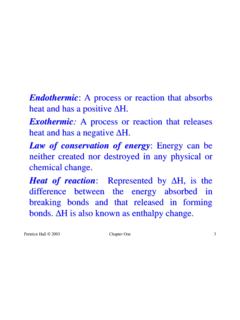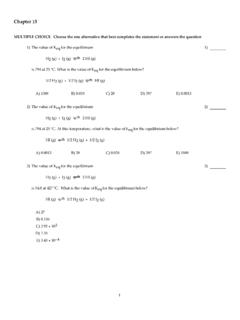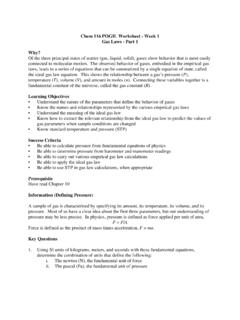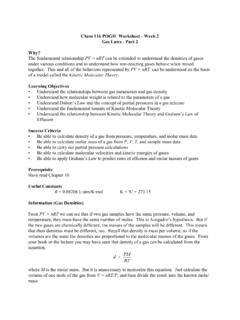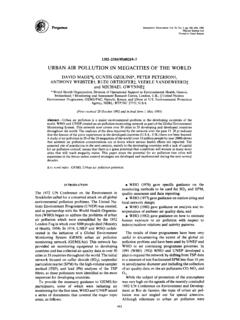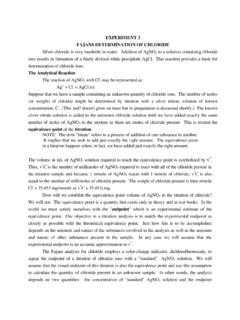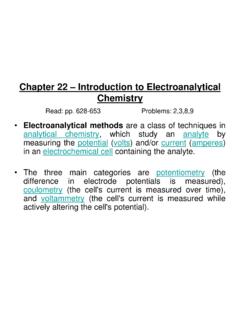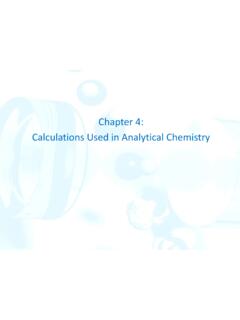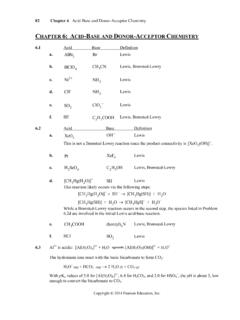Transcription of Organic Chemistry II / CHEM 252 Chapter 14 – Aromatic ...
1 Organic Chemistry II / CHEM 252 Chapter 14 Aromatic CompoundsBela TorokDepartment of ChemistryUniversity of Massachusetts BostonBoston, MA1 Introduction2- Historical name, based on smell, no relation to sturcture Nomenclature of Benzene Derivatives Benzene is the parent name for some monosubstituted benzenes; the substituent name is added as a prefix For other monosubstituted benzenes, the presence of the substituent results in a new parent nameIntroduction3 When two substituents are present their position may be indicated by the prefixes ortho, meta,and para(o, mand p) or by the corresponding numerical positions Dimethyl substituted benzenes are called xylenesIntroduction4 Numbers must be used as locants when more than two substituents are present The lowest possible set of numbers should be given to the substituents The substituents should be listed in alphabetical order If one of the substituents defines a parent other than benzene, this substituent defines the parent name and should be designated position 1 Introduction5 The C6H5- group is called phenyl when it is a substituent Phenyl is abbreviated Ph or A hydrocarbon with a saturated chain and a benzene ring is named by choosing the larger structural unit as the parent If the chain is unsaturated then it must be the parent and the benzene is then a phenyl substituent The phenylmethyl group is called a benzyl (abbreviated Bz)
2 Reactions of Benzenes6 Reactions of Benzene Even though benzene is highly unsaturated it does not undergo any of the regular reactions of alkenes such as addition or oxidation Benzene can be induced to react with bromine if a Lewis acid catalyst is present however the reaction is a substitution and not an addition Benzene produces only one monobrominated compound, which indicates that all 6 carbon-hydrogen bonds are equivalent Structure of Benzene7 The Kekule Structure for Benzene Kekule was the first to formulate a reasonable representation of benzene The Kekule structure suggests alternating double and single bonds Based on the Kekule structure one would expect there to be two different 1,2-dibromobenzenes but there is only one Kekule suggested an equilibrium between these compounds to explain this observation but it is now known no such equilibrium existsFriedrich August Kekule von Stradonitz8 Structure of Benzene The Stability of Benzene Benzene is much more stable than the cyclohexatriene A reasonable prediction for the heat of hydrogenation of hypothetical cyclohexatriene is -360 kJ mol-1(3 x cyclohexene, -120 kJ mol-1)
3 The heat of hydrogenation for benzene is -280 mol-1, 152 kJ mol-1more stable than hypothetical cyclohexatriene This difference is called the resonance energyStructure of Benzene9 Modern Theories of the Structure of Benzene The Resonance Explanation of the Structure of Benzene Structures I and are equal resonance contributors to the real structure of benzene Benzene is particularly stable because it has two equivalent and important resonance structures Each carbon-carbon bond is , which is between the length of a carbon-carbon single bond between sp2carbons ( ) and a carbon-carbon double bond ( ) Often the hybrid is represented by a circle in a hexagon (III)Structure of Benzene10 The Molecular Orbital Explanation of the Structure of Benzene The carbons in benzene are sp2hybridized with porbitals on all 6 carbons (a) The porbitals overlap around the ring (b) to form a bonding molecular orbital with electron density above and below the plane of the ring (c) There are six molecular orbitals for benzeneStructure of Benzene11 Huckel s Rule: The 4n+2 Electron Rule Planarmonocyclic ringswith a continuous system of porbitalsand 4n + 2 electronsare Aromatic (n = 0, 1, 2, 3 etc) Aromatic compounds have substantial resonance stabilization Benzene is Aromatic .
4 It is planar, cyclic, has a porbital at every carbon, and 6 electrons (n=1) There is a polygon-and-circle methodfor deriving the relative energies of orbitals of a system with a cyclic continuous array of porbitals A polygon corresponding to the ring is inscribed in a circle with one point of the polygon pointing directly down A horizontal line is drawn where vertices of the polygon touch the circle - each line corresponds to the energy level of the MOs at those atoms A dashed horizontal line half way up the circle indicates the separation of bonding and antibonding orbitalsStructure of Benzene12 Benzene has 3 bonding and 3 antibonding orbitalsAll the bonding orbitals are full and there are no electrons in antibonding orbitals; benzene has a closed shell of delocalized electrons and is very stableCyclooctatetraene has two nonbonding orbitals each with one electronThis is an unstable configuration; cyclooctatetraene adopts a nonplanar conformation with localized p bonds to avoid this instabilityAnnulenes13 The Annulenes Annulenes are monocyclic compounds with alternating double and single bonds Annulenes are named using a number in brackets that indicates the ring size Benzene is [6]annulene and cyclooctatetraene is [8]annulene An annulene is Aromatic if it has 4n+2 electrons and a planar carbon skeleton The [14]and [18]annulenes are Aromatic (4n+2, where n= 3,4) The [16] annulene is not aromaticAnnulenes14 The [10]annulenes below should be Aromatic but none of them can be planar 4 is not planar because of steric interaction of the indicated hydrogens 5 and 6 are not be planar because of large angle strain in the flat molecules Cyclobutadiene is a [4]annulene and is not Aromatic It does not follow the 4n+ 2 rule and is highly unstableEvidence of Electron Delocalization15 NMR Spectroscopy.
5 Evidence for Electron Delocalization in Aromatic CompoundsUV-Vis SpectroscopyAromatic Ions16 Cyclopentadiene is unusually acidic (pKa= 16) because it becomes the Aromatic cyclopentadienyl anion when a proton is removed Cyclopentadienyl anion has 6 electrons in a cyclic, continuous -electron system, and hence follows the 4n + 2 rule for aromaticity Cycloheptatriene is not Aromatic because its electrons are not delocalized around the ring (the sp3-hybrid CH2 group is an insulator ) Lose of hydride produces the Aromatic cycloheptatrienyl cation(tropylium cation) Aromatic Ions17 Aromatic Ions18 Anti- and Nonaromatic Compounds19 Aromatic , Antiaromatic, and Nonaromatic Compounds A comparison of cyclic annulenes with their acyclic counterparts provides a measures of the stability conferred by aromaticity ring has lower -electron energy than the open chain: Aromatic ring has the same -electron energy as the open chain: nonaromatic ring has higher -electron energy than the open chain: antiaromatic Benzene and cylcopentadientl anion are Aromatic Cyclobutadiene is antiaromatic Cyclooctatetraene, if it were planar, would be antiaromaticOther Aromatic Compounds20 Other Aromatic Compounds Benzenoid Aromatic Compounds Polycyclic benzenoid Aromatic compounds have two or more benzene rings fused togetherOther Aromatic Compounds21 Alkadienes and Polyunsaturated Hydrocarbons22 Naphthalene can be represented by three resonance structures The most important resonance structure is shown below the 10 electrons are delocalized.
6 It has substantial resonance energy Pyrene has 16 electrons, a non-Huckel number, yet is known to be Aromatic Ignoring the central double bond, the periphery of pyrene has 14 electrons, a Huckel number, and on this basis it resembles the Aromatic [14]annuleneNonbenzenoid Aromatic Compounds23 Nonbenzenoid Aromatic compounds do not contain benzene rings Examples are cyclopentadienyl anion and the Aromatic annulenes(except [6] annulene) Azulene has substantial resonance energy and also substantial separation of charge, as shown in the electrostatic potential mapFullerenes24 Fullerenes Buckminsterfullerene is a C60compound shaped like a soccer ball with interconnecting pentagons and hexagons Each carbon is sp2hybridized and has bonds to 3 other carbons Buckminsterfullerene is Aromatic Analogs of Buckyballs have been synthesized ( C70)Richard Buckminster FullerBioshpere25 Carbon Forms Forms of CarbonCharcoal Graphite Diamond FullerenesRobert F.
7 Curl JrSir Harold W. KrotoRichard E. SmalleyNobel Prize in Chemistry1996 Heterocyclic Aromatic Compounds26 Heterocyclic compounds have an element other than carbon in the ring Example of Aromatic heterocyclic compounds are shown below Numbering always starts at the heteroatom Pyridine has an sp2hybridized nitrogen The porbital on nitrogen is part of the Aromatic system of the ring The nitrogen lone pair is not part of the Aromatic system The lone pair on nitrogen is available to react so pyridine is basic27 Heterocyclic Aromatic Compounds The nitrogen in pyrrole is sp2hybridized and the lone pair is in the p orbital This p orbital contains two electrons and is in the Aromatic system The lone pair of pyrrole is part of the Aromatic system and not available for protonation; pyrrole is therefore not basic In furan and thiophene an electron pair on the heteroatom is also in a porbital which is part of the Aromatic systemHeterocyclic Aromatic Compounds28


